Characteristics and Importance of Volcanic Rock
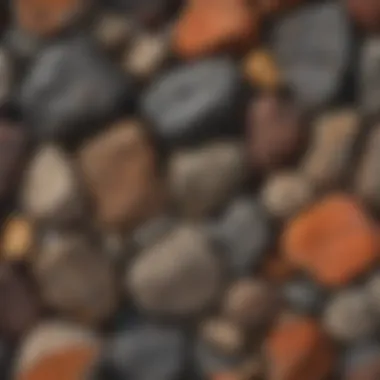
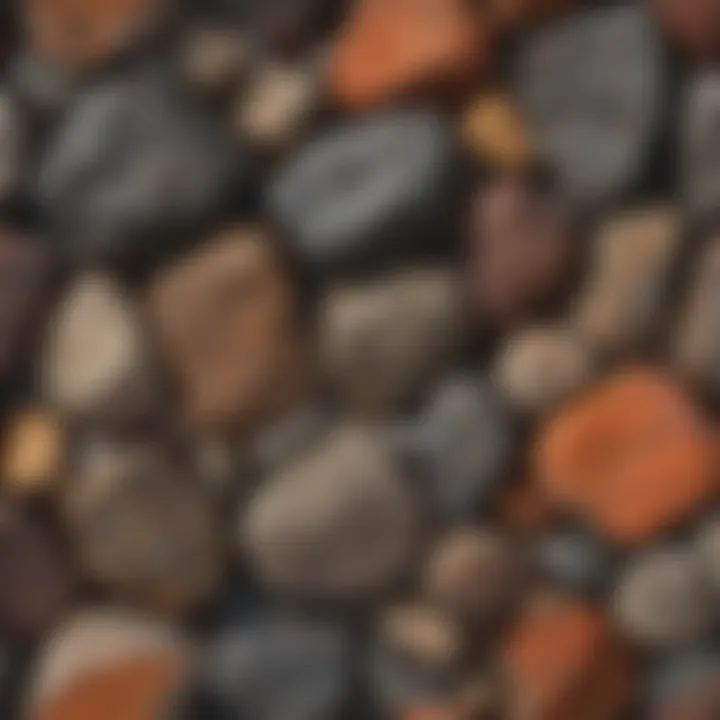
Intro
Volcanic rocks are not just remnants of the Earth's fiery past; they are the very building blocks of our planet's geology. From the towering peaks of the Andes to the rugged landscapes of Iceland, these rocks tell the story of volcanic activity and its impact on the Earth's evolution. As we explore the characteristics and significance of volcanic rock, we uncover not just their physical attributes, but also their profound cultural implications and aesthetic allure for collectors.
Understanding volcanic rocks requires an appreciation for their diverse formation processes, which vary significantly depending on the type of eruption, the cooling conditions, and the presence of volatile compounds. The interplay of these factors gives rise to a variety of rock types that each hold unique tales of creation and transformation.
As we embark on this journey, it becomes clear that volcanic rocks are more than mere geological specimens; they are potent symbols of nature's raw power and human ingenuity. Whether you are a seasoned collector or a novice enthusiast, the world of volcanic rocks offers insights into Earth’s dynamic processes and their lasting impact on our environment and culture.
In this article, we will traverse through the history of volcanic rocks, dissect their classification, and delve into their significance not just in geological studies but also in the realm of collecting.
Intro to Volcanic Rock
Volcanic rocks are more than just remnants of fiery explosions; they are fascinating testimonies to the Earth's inner workings and geological processes. Understanding volcanic rocks provides insights not only into their formation but also into the dynamics of our planet itself. This section serves as a crucial foundation for the discussions that follow, setting the stage for an exploration of their characteristics, significance, and diverse applications.
Definition and Overview
At its core, volcanic rock is formed from magma that erupts from beneath the Earth's surface. When magma escapes through a volcanic vent, it cools and solidifies into various types of rock, each with unique properties and textures. These rocks can be broadly categorized into two groups: those that cool swiftly on the surface, like basalt, and those that cool slowly underground before reaching the surface, such as granite, although granite is not classified as a volcanic rock. The rapid cooling results in fine-grained textures, while slow cooling yields coarse-grained structures.
For rock enthusiasts and collectors, the study of volcanic rock is a gateway to understanding both geological history and contemporary earth sciences. From the striking hues of obsidian to the light, pumice stones that float on water, volcanic rocks offer a variety of aesthetic and scientific intrigue.
Historical Context
The history of volcanic rocks dates back millions of years and intertwines with the evolution of the Earth itself. Early humans were quick to recognize the utility of volcanic materials. In ancient times, obsidian, known for its sharpness when fractured, was a preferred material for tools and weapons. Civilizations such as the Aztecs and the Romans capitalized on volcanic rock for construction, using tuff to create enduring structures.
In more recent history, volcanic activity has shaped landscapes, nurtured soil fertility, and even influenced weather patterns. The study of these rocks has transformed over the years, evolving from mere observation to detailed scientific inquiry. Today, geologists employ a mix of advanced technology and historical knowledge to analyze volcanic rocks, enabling them to predict future eruptions and understand the planetary processes at play.
"Volcanic rocks are like windows into the history of our planet, revealing past eruptions and the conditions of the Earth’s interior."
Through this historical lens, we can appreciate the dual significance of volcanic rocks—not just as geological specimens but also as part of human legacy and culture. Understanding these elements lays a solid groundwork for delving deeper into the more intricate aspects of volcanic rocks as we progress through this exploration.
Formation Processes of Volcanic Rock
Understanding the formation processes of volcanic rock is paramount to delineating the intricacies of how these natural artifacts emerge from the Earth's mantle to surface. This section elucidates critical concepts such as magmatic differentiation, cooling and solidification, and eruption dynamics, providing deeper context not only for collectors but also for those captivated by the Earth’s geology. Grasping these processes gives insight into the diversity and characteristics of volcanic rocks, allowing enthusiasts to appreciate their unique features and origins.
Magmatic Differentiation
Magmatic differentiation plays a crucial role in the formation of volcanic rocks. It is the process through which a single melt can evolve into various types of magma, each with different mineral compositions. This diversification occurs primarily when magma cools, affecting the mineral assemblage that crystallizes from it. The variations stem from factors such as temperature, pressure, and the surrounding rock formations.
During this phase, some minerals crystallize and settle out of the liquid magma. For example, olivine and pyroxene generally crystallize at higher temperatures and can sink to the bottom of a magma chamber. This leaves the residual magma, which can evolve to be richer in silica, leading to lighter rhyolitic rocks. Understanding this process is vital for collectors as it directly relates to the types of volcanic rock they may encounter and collect.
Cooling and Solidification
Following magmatic differentiation, the cooling and solidification phase will dictate the final form of the volcanic rock. When magma finally reaches the surface or near-surface conditions, it starts to cool rapidly. The rate of cooling greatly affects the texture and crystal size of the resulting rock. Quick cooling typically produces fine-grained textures, seen in volcanic rocks like basalt or pumice, while slower cooling can result in larger crystals, a characteristic of intrusive igneous rock but sometimes seen in volcanic settings as well.
Additionally, the cooling process can create unique formations such as columnar joints, where the cooling magma contracts in such a way that it forms polygonal columns—a stunning sight to observers and a point of interest for collectors.
Eruption Dynamics
Eruption dynamics encompass the myriad behaviors and mechanisms that govern volcanic eruptions. These dynamics determine not only the type of eruption—be it explosive like Mount St. Helens or effusive like Kilauea—but also the characteristics of the resulting volcanic rock. Explosive eruptions can fragment magma and produce ash, pumice, and other pyroclastic materials, while effusive eruptions tend to yield lava flows that solidify into basaltic formations.
The dynamics involve a complex interplay of gas pressure, magma composition, and the geological settings of the volcano. Understanding these elements is essential for collectors who study the origin and history of the rocks in their collections. Collectors may be particularly interested in obtaining pieces from different eruption types to better represent the spectrum of volcanic activity.
"Volcanic activity is a reflection of the dynamic processes within our planet, showcasing how the Earth's geological forces shape not just landscapes, but the very rocks we seek to collect and understand."
The formation processes of volcanic rocks are not merely scientific curiosities; they are the keys that unlock the stories of the Earth’s past. These processes link chemistry, physics, and geology, making volcanic rocks an invaluable focus for both scientific study and personal collection. The following sections will further explore the types and chemical compositions of these remarkable natural specimens.
Types of Volcanic Rocks
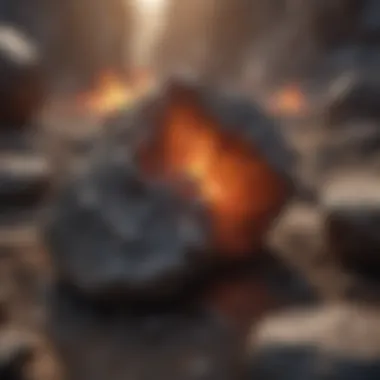
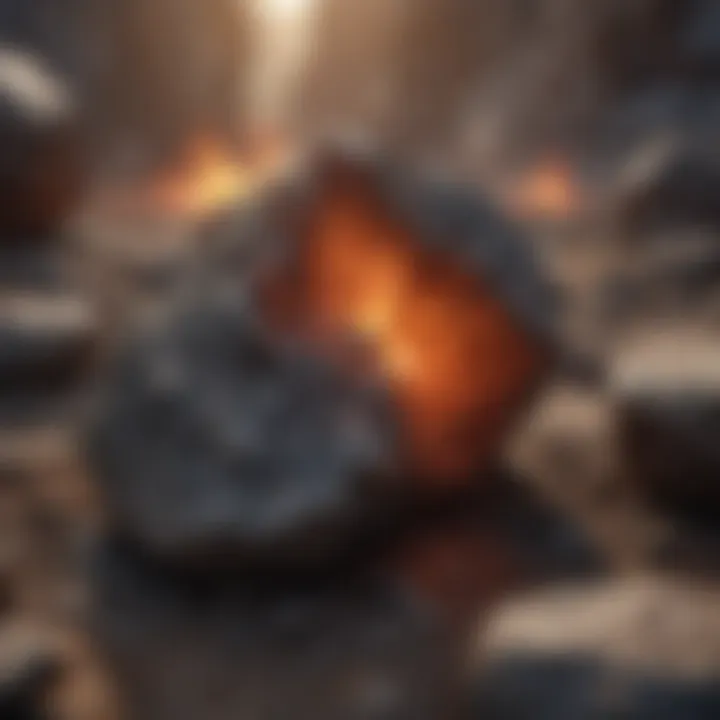
In the study of volcanic rocks, understanding the various types is essential. Each category possesses unique characteristics that influence not only how they form but also their uses in both natural processes and human applications. Recognizing these types can aid rock and fossil collectors in identifying genuine specimens, appreciating their aesthetic qualities, and understanding their geological significance.
Basalt
Basalt is one of the most common volcanic rocks, making up a significant portion of the Earth's surface, particularly oceanic crust. It originates from the rapid cooling of lava that flows out of volcanoes during eruptions. The formation process results in a fine-grained texture due to the quick solidification, which prevents large crystals from developing.
Basalt typically contains a mix of minerals such as pyroxene and plagioclase, giving it its characteristic dark color. Collectors often seek out basalt for its durability and aesthetic appeal, especially when polished. Additionally, basalt's role in environmental processes is notable. It weathers slowly, contributing to soil formation and influencing the nutrient cycles in volcanic regions.
Pumice
Pumice is a fascinating volcanic rock formed during explosive eruptions. This type is unique due to its frothy texture, which results from gas bubbles trapped in the lava as it cools. The rapid ascent of magma allows these bubbles to expand, creating a rock that is light enough to float on water.
From a collector's perspective, pumice offers a myriad of uses. Its lightweight nature makes it an excellent material for various industries, including beauty (pumice stones for exfoliation) and gardening (as a soil amendment). Pumice can also serve as a volcanic gift for art projects due to its porous appearance, adding distinctive character to any creation. When sourcing pumice, collectors should look for irregular shapes with visible vesicles, as these features define high-quality specimens.
Obsidian
Obsidian stands out for its glassy luster and sharp edges. Formed from rapidly cooled lava, obsidian cools so quickly that crystals do not have time to form, resulting in a smooth and reflective surface. This rock historically held significant value, as its sharp edges made it an exceptional material for tools and weapons. Today, it still captures the interest of collectors for both its beauty and historical importance.
When collecting obsidian, enthusiasts often look for variations such as rainbow obsidian or snowflake obsidian, which feature distinct color patterns created by mineral inclusions. However, caution should be exercised as some imitations on the market may lack the genuine properties of naturally occurring obsidian.
"Obsidian's beauty is not just skin-deep; it offers insights into volcanic processes that shaped our world."
Tuff
Tuff might not get the same spotlight as basalt or obsidian, but it is equally important in the volcanic rock family. Formed from volcanic ash ejected during eruptions, tuff is a lightweight, porous rock often used in construction and landscaping. Its ability to trap air makes it an excellent insulator, and its unique texture can be visually appealing in decorative applications.
For collectors, tuff varieties span a range of colors and textures depending on the mineral content and environmental conditions during formation. Tuffs rich in silica can appear lighter and more porous, while those with iron can take on darker hues. Understanding the local geology where tuff is sourced can enhance its value to a collector, making it a fascinating topic of investigation.
The exploration of these types of volcanic rocks not only aids in appreciation but also offers insights into geological processes that have shaped our planet. Collectors must approach each rock with curiosity and respect, understanding the natural history embedded in each specimen.
Chemical Composition of Volcanic Rocks
Understanding the chemical composition of volcanic rocks is key to appreciating their formation and significance in both geological studies and for collectors. The makeup of these rocks not only determines their physical properties but also sheds light on the processes that created them deep within the Earth. This composition influences aspects such as their color, texture, and even their reaction to weathering and erosion. For collectors, knowing the chemical structure can help in identifying authentic specimens and assessing their value.
Major Elements
Volcanic rocks are primarily composed of silicate minerals, which consist mainly of SiO2, or silica. This element plays a crucial role as it forms the backbone of many minerals found in these rocks. Other major elements include:
- Aluminum (Al): Found in feldspars, this element contributes to the solidity and layering seen in basaltic formations.
- Iron (Fe): Often found in the form of iron oxides, it influences the color, giving rocks a darker hue, especially in basalt.
- Magnesium (Mg): This element, along with iron, is key in forming olivine, a mineral common in some volcanic rocks.
- Calcium (Ca): Present in plagioclase feldspar, calcium impacts the rock’s density and is essential for differentiating between types of volcanic rocks.
- Sodium (Na) and Potassium (K): These elements are also crucial, affecting the overall chemical balance of volcanic rocks.
Each of these major elements combines in various proportions, giving rise to different types, textures, and even behaviors during volcanic eruptions. The balance of these elements is what makes every volcanic rock unique.
Trace Elements and Their Significance
Beyond the primary elements, trace elements (those found in smaller quantities) further enhance our understanding of volcanic rocks. Elements like zinc, copper, and lead might not be present in significant amounts but serve vital functions. Their presence can be indicators of the conditions under which the rock formed. Also noteworthy is the role of trace elements in geochemical processes. For example:
- Copper (Cu): High concentrations can suggest a history of hydrothermal alteration, common in volcanic regions.
- Zinc (Zn): Its levels may provide insights into the source magma and the depth of crystallization during formation.
- Rare earth elements (REE): These, though scarce, can be instrumental in tracing the geological history and alterations that the volcanic rock has undergone.
"The study of trace elements in volcanic rocks not only unravels the past but also aids in predicting future volcanic activity and its geological ramifications."
Physical Properties of Volcanic Rock
Understanding the physical properties of volcanic rock is crucial for rock and fossil enthusiasts. These properties not only define the look and feel of the rock itself but also reveal insights about its formation and the conditions under which it was created. From texture variations to density measurements, each characteristic plays a significant role in identifying volcanic rocks and appreciating their unique stories.
Texture and Structure
The texture and structure of volcanic rocks can vary dramatically, giving collectors a rich tapestry to explore. For instance, basalt, often characterized by its fine-grained texture, showcases rapid cooling that takes place when lava spills out onto the Earth’s surface. In comparison, a rock like pumice—often light and porous—forms from volcanic gases that get trapped during solidification.
This texture tells a tale of its origin. One can observe that a glassy texture, like that found in obsidian, comes from nearly instantaneous cooling of lava. This contrasts with rocks exhibiting a more vesicular texture, where gas bubbles leave behind tiny holes, resulting in a frothy appearance. It's important to note that these features can also affect how easily the rock can be handled or displayed in a collection.
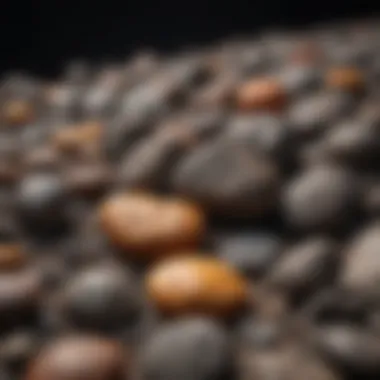

Density and Porosity
Density and porosity give more than just a clue about how much material is packed into a specimen; they also hint at how the rock formed. Basalt, generally denser due to its mineral composition, contrasts sharply with pumice, which can float on water due to its high porosity.
Understanding these aspects can inform collectors about the rock's potential uses and durability. A rock with high porosity might be unsuitable for certain decorative applications, while denser variations may serve well in construction or jewelry making.
"The density of volcanic rocks can vary, impacting their weight and handling characteristics. Knowing these details can aid collectors in making informed choices about exhibiting or selling their finds."
Colors and Aesthetics
Volcanic rocks often come in a stunning array of colors, adding to their allure for collectors. Basalt, for instance, is usually black or dark grey, which often gives it a striking contrast when placed alongside lighter colored rocks like tuff, which can have creams and browns depending on its mineral content.
The beauty of volcanic rock isn't just in its color but also in the patterns these formations can exhibit. The swirling effects seen in certain obsidian specimens can create a mesmerizing effect, while the earthy tones of tuff can evoke a connection to the natural world.
When considering these aesthetic aspects, collectors should tap into how the colors reflect the history of the rock. Specific hues may indicate variations in temperature, pressure, or even the type of lava involved in the eruption. Recognizing these details enhances appreciation for the art of nature embedded in these rocks.
Volcanic Rock in Geological Studies
The realm of geological studies greatly benefits from volcanic rocks, as they are more than just remnants of eruptions—they embody significant narratives of Earth's tumultuous history. By analyzing these rocks, geologists can decipher a plethora of patterns related to volcanic behavior and Earth's internal structure. Furthermore, the insights gained from volcanic rock influence not only theoretical geology but also practical applications such as hazard assessment in volcanically active regions and natural resource exploration.
Chronology and Dating Techniques
Dating volcanic rocks is crucial for understanding their history and the geological timeline of an area. Techniques such as radiometric dating help determine the age of these rocks, providing insights into when a particular eruption occurred. For instance, methods like potassium-argon dating rely on the decay of potassium to argon, which can offer dates for lava flows that are millions of years old.
- Uranium-Lead Dating: Often used for older rocks, this method can yield ages for samples that date back billions of years.
- Fission Track Dating: This technique works by counting the number of tracks left in a mineral sample by the spontaneous fission of uranium-238.
The chronology derived from these methods provides a framework, aiding researchers in correlating volcanic events with climatic or tectonic changes. By piecing together timelines, scientists can enhance predictions on future volcanic activity, an invaluable asset for communities living near volcanoes.
Tectonic Plates and Volcanic Activity
Volcanic activity doesn't happen in a void; it's highly connected to tectonic processes. Most volcanoes form at the boundaries of tectonic plates, and understanding these interactions is vital for geologists.
Key relationships to explore:
- Divergent Boundaries: Here, tectonic plates pull apart, allowing magma to rise and create new crust. The Mid-Atlantic Ridge serves as a prime example, featuring a series of underwater volcanoes.
- Convergent Boundaries: This is where one plate dives beneath another, leading to significant volcanic activity. The Pacific Ring of Fire is rich with explosive volcanoes, marked by subduction zones.
Moreover, volcanic rocks can serve as indicators of plate movement. For instance, the mineral composition of rocks can suggest the environment from which they originated, guiding researchers in understanding how tectonic plates have shifted over millennia.
"Studying volcanic rocks not only brings us closer to grasping Earth's past but also holds the keys to predicting its future."
The intricate relationship between volcanic rocks and tectonic activity compels geologists to dig deeper, fostering a greater appreciation for the dynamic nature of our planet. Thus, volcanic rocks are not merely geological curiosities but are essential in unraveling the complexities of Earth's geodynamic processes.
Cultural Significance of Volcanic Rock
The connection between volcanic rock and human culture runs deeper than many might appreciate. These stones have influenced societies, not just as geological specimens, but as integral parts of evolving traditions and technologies. They tell stories, embody heritage, and inspire creativity. The cultural significance of volcanic rock instinctively draws those who appreciate the Earth’s dynamic nature and the history imprinted on its surface. We observe how communities harness these rocks, each tectonic event creating a canvas for shared identities and practices.
Historical Uses
Since ancient times, volcanic rock has played a vital role in shaping human activities. Early civilizations utilized basalt and pumice to craft tools, and the durability of these materials was unmatched. For instance, in ancient Roman structures, tuff, a type of volcanic rock, served as a fundamental building block due to its lightweight and insulating properties. This connection reveals how rocks can bear historical weight, quite literally in the case of the architectural marvels that still stand today.
Many cultures revered volcanic regions, viewing them as sacred sites. The presence of volcanic activity inspired mythologies and rituals. People in Hawaii, for instance, venerate Pele, the goddess of fire and volcanoes. The lava stones are viewed not merely as material but as spiritual vessels connecting to their ancestry. Volcanic rock, then, is not just matter; it resonates with human expression and belief, binding community and land together.
Contemporary Applications
Fast forward to our modern era, the relevance of volcanic rock hasn’t dimmed; in fact, it has evolved into new arenas. Architects and artists are rediscovering these materials, employing them in innovative designs that marry function with aesthetic appeal. Basalt has found a place in contemporary landscaping, its rugged appearance complementing modern architectural styles while promising durability.
In industry, volcanic materials have found application in construction due to their light weight and insulating properties, making them an environmentally friendly resource. Certain volcanic rocks are used in geothermal energy technologies, harnessing the Earth's heat in a sustainable manner. This pivot towards sustainable practices illustrates the transition of volcanic rock from ancient tools to modern innovations.


"Volcanic rock integrates the past with the present, offering endless possibilities for future generations involved both in conservation and construction alike."
The global art scene has seen an influx of artists using volcanic materials to symbolize transformation and resilience, further driving home their cultural importance. By engaging with volcanic rock, collectors and artists form a dialogue with history, echoing the stories carved into the landscape both literally and metaphorically.
In summary, volcanic rock stands at the intersection of history, culture, and modernity, proving its worth beyond geology. From ancient tools to contemporary architectural wonders, its presence has been felt, shaping societies and collected into narratives that resonate today.
Collecting Volcanic Rock
Collecting volcanic rock is not merely a hobby; it's a gateway to understanding Earth's past and present. As collectors delve into this realm, they uncover stories written in stone, tales of fiery eruptions and gradual cooling that have shaped landscapes over millennia. With a global array of volcanic rocks available, the quest becomes not just about gathering specimens, but appreciating their geological and cultural significance.
Identifying Genuine Specimens
When it comes to collecting volcanic rock, the ability to distinguish genuine specimens is foundational. First, collectors need to familiarize themselves with the key characteristics of various volcanic rocks. For example, basalt is typically fine-grained and dark in color; its porous nature is a telltale sign of its volcanic origin. In contrast, pumice floats due to its highly vesicular texture, created by gas bubbles during eruption. There are a few strategies to ensure that the specimens are authentic:
- Visual Examination: Careful scrutiny of color and texture can reveal a lot. Look for the unique surface patterns that volcanic rocks exhibit due to the rapid cooling of lava.
- Weight Test: Volcanic rocks like pumice should feel light compared to their size—the lower density is a key indicator.
- Location Context: Knowing where the rock was sourced can aid in identification. Collect from recognized locations, or seek out trusted sellers who provide geographical context.
"In the world of rock collecting, knowledge is your best tool. Understanding the origin and characteristics of each specimen not only fosters appreciation but also enhances the value of your collection."
Valuation Techniques
Valuing volcanic rock specimens involves a nuanced approach that balances aesthetic appeal with scientific significance. Not all volcanic rocks are created equal, and their worth can vary based on a range of factors. Here are some considerations for appraising your volcanic rocks:
- Rarity: Rocks sourced from rare eruption sites or those with unique mineral compositions are likely to fetch a higher price. For instance, a piece of obsidian from a lesser-known volcanic site may be highly desired by collectors.
- Condition and Quality: The condition of a specimen plays a major role. Cracks, chips, or excessive wear can diminish value, while well-preserved specimens are typically more sought after.
- Geological Significance: Some volcanic rocks tell a story about their formation processes, such as those displaying distinct layering or unusual crystal habits. Specimens with such characteristics can command greater interest from geologists and serious collectors alike.
- Market Trends: Just like any collectible, volcanic rock prices can fluctuate with trends in collecting. Keeping a keen eye on forums, marketplaces, and rock shows can provide insights into current demand and valuation adjustments.
By situating the specimens within both personal context and broader geological narratives, collectors can not only elevate the importance of their findings but also ensure they are investing wisely in their passion.
Care and Maintenance of Volcanic Rock Collections
Proper care and maintenance of volcanic rock collections is essential for any serious collector. These geological treasures, while durable, require thoughtful handling and preservation techniques to retain their beauty and integrity over time. Understanding how to clean, preserve, and display these pieces can make all the difference in their appearance and longevity.
Cleaning and Preservation Techniques
Cleaning volcanic rocks isn't just about aesthetics; it's about preserving their unique properties. Different types may require different approaches:
- Gentle Wash: For most specimens, a soft brush and lukewarm water will do wonders. Avoid harsh chemicals, as they can damage the rock's surface, especially for porous materials like pumice.
- Avoiding Abrasion: Ensure that brushes have soft bristles. Going too hard can wear down the rock, reducing its overall value. Remember to be gentle!
- Drying Techniques: After washing, it’s crucial to let them air dry in a cool, shaded place. Direct sunlight can cause thermal shock to certain rocks, particularly obsidian. Unlike a stubborn stain on a shirt, volcanic rock often tells a story; be considerate of its history.
- Long-term Preservation: Store each piece carefully to avoid scratches and breaks. Use display cases made of glass or acrylic; they protect from dust but allow for visibility.
"The beauty of volcanic rock lies within its imperfections; every crack and crevice carries a tale of its fiery origins."
Displaying Collections Effectively
Displaying your volcanic rock collection can enhance its aesthetic appeal and educational potential. A thoughtfully arranged display not only highlights the natural beauty of each piece but also communicates the geological history behind them.
- Lighting Matters: Natural light can illuminate colors, but too much can fade specimens. Consider using LED lights for an even, gentle glow.
- Arrangement Techniques: Group rocks by type or color. For example, a display of vibrant basalt contrasts beautifully beside the soft hues of pumice.
- Labels and Information: Adding small labels with the name, origin, and maybe a fun fact can turn a display into an informative exhibit. This way, visitors—friends or family—can appreciate not just the visual beauty but also the science behind them.
- Rotating Displays: Consider rotating your collection every few months. This not only keeps the display fresh but allows you to enjoy all parts of your beloved collection.
In summary, taking time to care for and display your volcanic rock collection appropriately greatly enhances its beauty and educational value. It's not just geology; it’s a glimpse into the Earth's history.
Culmination
The conclusion serves as a crucial component in this exploration of volcanic rocks, encapsulating the essence of what has been discussed throughout the article. Its significance lies not just in summing up information but in reinforcing the transformative nature these rocks can have on both scientific understanding and personal passion for collecting.
In highlighting the key points, we re-emphasize the processes that give birth to volcanic rocks, their diverse types, and remarkable properties. This coherence aids enthusiasts in recognizing the underlying patterns in volcanic activity and rock formation, enriching their appreciation for the specimens they collect.
Summary of Key Points
- Volcanic rocks are formed through intricate geological processes, primarily associated with volcanic eruptions and cooling periods.
- The diversity of types such as basalt, pumice, obsidian, and tuff showcases a wide range of textures and chemical compositions.
- These rocks play an essential role in geological studies, offering insights into Earth's history and dynamics through techniques like radiometric dating.
- Cultural significance, from historical uses to contemporary applications, highlights the connection humans have with these natural artifacts.
- Proper methods for collecting, valuing, and maintaining volcanic rocks ensure their preservation for future admiration and study.
The comprehensive overview provided here presents volcanic rocks not only as geological specimens but also as pieces of natural art, awaiting appreciation.
Future Prospects in Volcanic Rock Studies
Looking ahead, the study of volcanic rocks stands poised for further exploration and discovery. As technology advances, methods like remote sensing and geochemical analysis develop, providing deeper insights into volcanic activity and magma composition.
Moreover, with climate change concerns becoming more urgent, understanding volcanic rocks may shed light on their impact on the environment, including the release of gases and ash during eruptions. Collectors can look forward to potentially uncovering new types of volcanic rocks or discovering rich deposits that had long been overlooked.
Collectively, these prospects not only invigorate academic research but also fuel the passion of rock enthusiasts who seek to expand their collections with new findings. In a world where nature continues to evolve, the link between volcanic rocks and Earth's processes remains a testament to the planet's untamed beauty and complexity.



